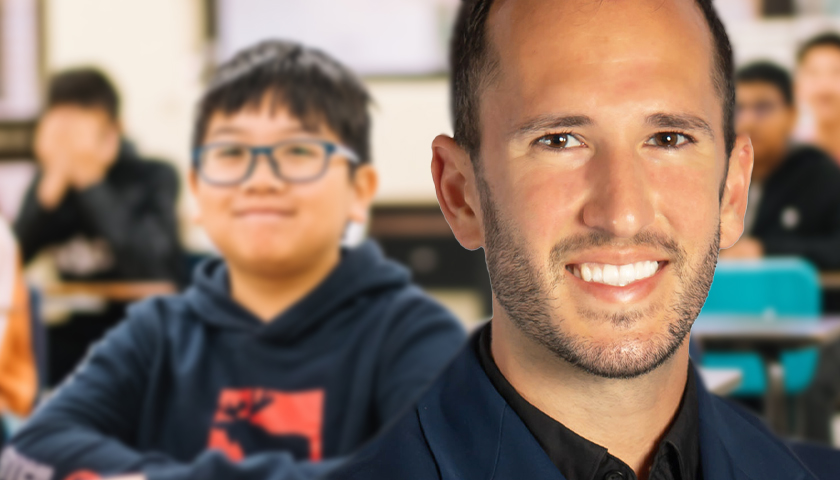In an interview with The Star News Network, nationally known school choice advocate Corey A. DeAngelis said teachers’ unions would be incentivized to push for more student-focused policies in public schools if school funding followed the child and more states adopted school choice programs.
DeAngelis, the national director of research at the American Federation for Children, is also an adjunct scholar at the Cato Institute, and a senior fellow at the Reason Foundation. He referred to the Minneapolis teachers’ union strike, now in its second week, and tweeted, “defund teachers unions”:
It’s amazing that they’re striking after two years of COVID school closures in some places. The problem that I see with all of this is partially the teachers’ unions, but, also, they’re coupled with a lack of school choice. If we had the funding following the child, well, then, perhaps teachers’ unions would have a stronger incentive to push for policies that actually help kids.
defund teachers unions. https://t.co/cBWIDCIs7s
— Corey A. DeAngelis, school choice evangelist (@DeAngelisCorey) March 16, 2022
DeAngelis made his point about school choice by hypothesizing a similar situation in the private sector:
I mean, just think about unions, which could exist in the private sector. Just imagine if employees at Walmart decided to strike for a week. That would be kind of inconvenient, but it wouldn’t be devastating for parents and families because they could take their money to Trader Joe’s, or Safeway, or another provider of groceries. And in that scenario, if Walmart employees were able to strike, you’d be able to take your money elsewhere. I think if public school employees strike, families should similarly be able to take their children’s education dollars elsewhere.
In the private sector, if the employees don’t show up to work, the employers are the ones who feel the pain.
With public sector teachers’ unions, however, the families and children are burdened as long as union bosses’ demands are not met, DeAngelis observed.
“In the public school sector, it’s the customers, the families, who feel the pain, so you have this never-ending cycle of a feedback that doesn’t make its way to the employer,” he explained. “It makes its way to the customers, which leaves you stuck in this never-ending cycle, which is completely backwards.”
DeAngelis said rather than focus on how to eliminate public teachers’ unions in order to save government-run schools, he believes that greater school choice would allow the “incentives to be aligned in the right way.”
“So, there could be redemption, there could be an improvement in the public school system, but we would need the funding to follow the child, and then it wouldn’t matter so much if teacher unions existed, because they would have a stronger incentive to do the right thing,” he said. “So, public schools could improve, but we just need to fix the incentives that currently are not aligned in the traditional school system.”
The school choice champion explained in a tweet Wednesday exactly how the current system is “completely backwards,” where “underperforming private schools shut down,” but “underperforming government schools get more money.”
underperforming private schools shut down
underperforming government schools get more money. https://t.co/jTL6EbGg56
— Corey A. DeAngelis, school choice evangelist (@DeAngelisCorey) March 17, 2022
DeAngelis commented on the sharp decline in enrollment in public schools. Since the pandemic, when parents were at home viewing their children’s remote learning lessons, many were unhappy with what they saw, and found other education settings that they chose to continue even after in-school learning finally resumed:
Nationwide, I believe the enrollment drop in public schools is about 1.5 million students, or more, which was roughly about a 3% decline in enrollment. We saw Census Bureau numbers suggesting a doubling of homeschooling relative to pre-pandemic levels. Charter school enrollment jumped by 7%, whereas the government run school enrollment dropped by about 3%. And, so, people were voting with their feet even before these massive expansions of school choice that we saw in 2021, the year of school choice.
“Just imagine if we had universal school choice, if all of the funding followed the child, every single child, to wherever they wanted to get an education?” DeAngelis noted. “We probably would have seen a much larger exodus from the government- run school system in the pandemic period.”
The scholar explained why he views education savings accounts as the “gold standard of school choice” funding mechanisms:
An education savings account program differs from a voucher program in that the funding that would have gone to the government-run school follows the child to something called an education savings account, which can be directed by the parent and be used at any approved education provider, or could be used for private school tuition and fees, much like a voucher.
Unlike a voucher, however, DeAngelis said education savings accounts “can also be used for micro schooling, home education expenses, curriculum, private tutoring, and any other approved education expense.”
“So, it almost takes us from school choice to education choice, and it allows for the maximum flexibility on the part of the parent,” he explained.
DeAngelis assessed the progress he has seen in the states in the arena of school choice:
From what I’ve seen this year, in 2022, I’ve tracked 34 states in which legislators have introduced legislation to fund students, as opposed to systems, and the vast majority of those states had an education savings account proposal.
He added the terminology surrounding education savings accounts may change, depending on the state.
“Some states call them education scholarship accounts,” he noted. “New Hampshire called theirs an education freedom account, but it’s the same basic mechanism. Those are the types of proposals that seems we’re seeing more and more often.”
DeAngelis said the fact that most Democrats vote against school choice legislation is a reflection of “power dynamics” that have little to do with “logic.”
“The logic for school choice – it’s a non-partisan issue, especially when you think about how Democrats, in general, will support funding following the student for higher education with Pell Grants,” he explained. “And, they support funding the student when it comes to pre-K programs, including the federal Headstart program. You could take your taxpayer funding for the pre-K program to a private, religious, or non-religious provider. The funding follows the decision of the family.”
He continued with the lack of “logic” in Democrats’ insistence school choice “hurts” government-run public schools:
We fund people directly when it comes to food stamps, Medicaid, Section Eight housing vouchers, and so many other taxpayer initiatives that are supported by Democrats. But, only when it comes to K-12 education is there a larger amount of opposition coming from the Democrat Party. And that doesn’t make sense at first, especially when you think about it in terms of the logic of the funding following the person as opposed to the building.
It only starts to make sense when you understand that there’s a difference in power dynamics, where with higher education, pre-K, and just about everything else choice is the norm, but choice threatens an entrenched special interest when it comes to K-12 education. And that special interest, the teachers’ union, of course, fights as hard as possible against change to the status quo.
DeAngelis observed that during every campaign cycle since 1990, the American Federation of Teachers (AFT), led by Randi Weingarten, has donated 97 percent of its campaign contributions to Democrat candidates.
“And in most of those campaign cycles, the amount was over 98% of the total,” he added.
According to a report at Roll Call in April 2021, the AFT political action committee (PAC) disclosed giving $1.6 million to congressional candidates and committees, including $1 million to House Majority PAC, a super PAC that boosts Democratic candidates.
The report continued:
The uptick in donations, almost entirely to Democrats, came as the debate over remote schooling became political fodder. Congressional Republicans have criticized Democrats for being too cozy with teachers’ unions, a longstanding political ally, and thwarting school reopenings. Democrats say they, too, have worked to get students back into classrooms and pushed for extra federal funding in COVID-19 relief legislation, much of it to be spent in the coming years, for public education.
DeAngelis said, when it comes to school choice, Democrats “are in a tough position.”
“Even if they support the idea of school choice, logically and morally, and they do when you look at the polling on the ground when it comes to their constituents,” he observed.
A RealClear Opinion Research Poll published February 28 surveyed more than 2,000 registered voters and found 72% of respondents support school choice, compared to 18% who oppose the concept.
That outcome includes 68% of Democrats, 82% of Republicans, and 67% of Independents in support of school choice.
The findings also represent substantial increases in support for school choice since the pandemic, when teachers’ unions insisted schools remain closed.
Overall support for school choice jumped 8 percentage points from 64 percent in April 2020 to 72 percent in 2022. Democrat support rose 9 percentage points, from 59 percent to 68 percent, while Republican and Independent support increased 7 percentage points, from 75 percent to 82 percent, and 60 to 67 percent, respectively.
“But, for Democrats to actually vote for school choice policies – that has a lot to do with the influence of the teachers’ unions,” DeAngelis said, and tweeted his support Wednesday for the concept that “parents are the new special interest group.”
Politicians should be listening to parents! pic.twitter.com/nAuTaCHxoe
— Parent Union (CPC) (@ParentUnionCPC) March 17, 2022
Asked by The Star News Network about the impact of the teaching of Critical Race Theory and pandemic mandates, including mask requirements in schools and the pressure to vaccinate children, on the exodus from public schools, DeAngelis responded:
I’d say all of these issues that we’ve seen bubbling up over the past two years – whether it’s remote learning vs. in-person learning, whether it’s this curriculum or that curriculum, or this COVID mitigation measure or that COVID mitigation measure – they’re all just symptoms of the larger issue, which happens to be that we’ve forced millions of families to send their kids to a one-size-fits-all government-run school system.
“Parents disagree about how they want their kids raised, and how they want their children to be educated,” he observed. “And by definition, a one-size-fits-all system is just not going to work, whatever the curriculum is, whatever the discipline strategy is, whatever policy is implemented in the public school system, it’s by definition, not going to work for a large segment of the population, even if it works for the majority of kids.”
– – –
Susan Berry, PhD, is national education editor at The Star News Network. Email tips to [email protected].
Photo “Corey DeAngelis” by American Federation for Children.






[…] A. DeAngelis, national director of research at the American Federation for Children, spoke to The Star News Network last week about the plummeting enrollment in public […]
[…] A. DeAngelis, national director of research at the American Federation for Children, spoke to The Star News Network last week about the plummeting enrollment in public […]
PS – Hegelian Dialectic is used to manipulate parents to support “school choice”. Example, Michigan, where property taxes were raised to the point that the public began complaining. Most tax dollars fund public schools. In order to appease the public the governor opened the state to corporations to build private schools. Taxes were then lowered.
In the example of Corey DeAngelis, the Hegelian Dialectic is that teachers strike, that wouldn’t happen if you put your kids in private school.
They create the problem then offer the solution which is always private schools.
I do not know anything about Corey nor the institutions that he is associated with. But I do know that school choice means that corporations simply use public money and create schools that are conditioned upon teaching kids to tests. Technology is used in place of teachers and stimulus-response is the method they use to condition children to be an obedient work force for the future. They are not taught to think or reason or explore or learn. They are taught to be future corporate workers. Data is collected on each student and corporate elites determine where they should be placed and what job they are capable of doing.
School World Order by John Klyczek is an excellent book to learn about government/corporate takeover of our public school system.